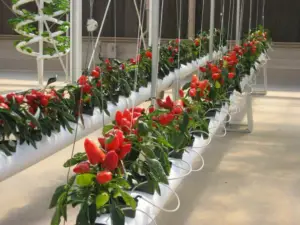Grow Peppers Hydroponically: A Complete Guide to Success
Are you tired of relying on store-bought peppers that lack flavor or are limited by seasonality? Want greater control over how your food is grown? Hydroponic gardening puts you in the driver’s seat! By carefully managing their growing environment, you can unlock your peppers’ full potential. This means faster growth cycles, the ability to grow a wider variety of peppers, and the satisfaction of knowing exactly how your food was produced.
Whether you’re craving sweet bell peppers, spicy jalapeños, or exotic varieties, hydroponics gives you the power to cultivate them on your terms. Discover the joy of harvesting fresh, flavorful peppers right from your own home, all year round.
Why Grow Peppers Hydroponically?
Growing peppers hydroponically offers a range of exciting benefits that go beyond what traditional gardening can provide:
-
Faster Growth: By delivering nutrients directly to the roots, hydroponic systems accelerate plant growth. Expect your peppers to mature significantly faster than their soil-grown counterparts.
-
Increased Yields: A well-managed hydroponic setup allows you to optimize the growing environment for maximum pepper production. This translates to more abundant harvests in the same amount of space.
-
Year-Round Cultivation: Forget seasonal limitations! Hydroponics lets you grow peppers indoors regardless of the weather outside. Enjoy a continuous supply of fresh, homegrown peppers.
-
Reduced Pests and Diseases: The controlled environment of a hydroponic system significantly minimizes the risk of pests and diseases common in soil gardens.
-
Water Conservation: Hydroponic systems recirculate water, making them incredibly water-efficient compared to traditional gardening methods.
Choosing the Right Hydroponic System
The world of hydroponics offers several effective methods for growing peppers. Consider the following popular options, each with its own advantages:
-
Deep Water Culture (DWC): This simple, beginner-friendly system is a fantastic choice for peppers. Plant roots are suspended in a nutrient-rich solution that’s kept oxygenated by an air pump and air stone. DWC is low-maintenance and well-suited for a variety of pepper plant sizes.
-
Nutrient Film Technique (NFT): NFT systems feature a gently sloping channel through which a thin film of nutrient solution continuously flows. This method is ideal for larger pepper varieties or if you aim to grow many plants at once. NFT promotes rapid root development and offers efficient nutrient delivery.
-
Kratky Method: Perfect for those seeking a low-maintenance option, the Kratky method is entirely passive. Plants are placed in a container with a nutrient solution, leaving an airspace above the solution as roots grow downwards. This method is simple to set up and ideal for smaller pepper varieties.
-
Ebb and Flow (Flood and Drain): This versatile system periodically floods your grow tray with nutrient solution, which then drains back into a reservoir. Ebb and Flow systems are adaptable to different plant sizes and are a good option for more experienced hydroponic growers.
-
Drip System: Drip systems deliver nutrient solution directly to the base of each plant through emitters. This approach provides excellent control over watering and fertilization. Drip systems are efficient and customizable to your specific setup.
Factors to Consider:
-
Experience Level: Choose a system that suits your hydroponics knowledge (DWC and Kratky are great for beginners).
-
Space: Consider the footprint of your chosen system.
-
Pepper Varieties: Larger pepper plants may benefit from the support offered by NFT or Ebb and Flow systems.
Essential Factors for Hydroponic Pepper Success
Mastering a few key elements will ensure your hydroponic peppers flourish. Let’s break them down:
-
Light: Peppers are sun-loving plants! Aim for 14-16 hours of bright light per day. If natural sunlight is insufficient, consider supplementing with LED or HID grow lights. These are specifically designed to provide the light spectrum plants need for optimal growth.
-
Temperature: Peppers thrive in a warm environment. Maintain an air temperature between 65-80°F (18-27°C) for optimal growth. Avoid drastic temperature fluctuations, as this can stress your plants and lead to blossom drop.
-
pH: The pH of your nutrient solution determines how well your plants absorb nutrients. Peppers prefer a slightly acidic pH range of 5.5-6.5. Regularly test and adjust your pH as needed using pH up or pH down solutions.
-
Nutrients: Choose a hydroponic nutrient solution specifically designed for fruiting vegetables like peppers. These solutions contain macro and micronutrients essential for healthy growth, flowering, and bountiful harvests. Follow the manufacturer’s instructions for mixing and application.
-
Support: As pepper plants grow taller, they may require support to avoid toppling over. Use stakes, trellises, or gentle tying to support the plant’s weight and encourage vertical growth.
-
Pollination: If growing peppers indoors, you may need to assist with pollination. This is because the lack of insects indoors can hinder natural pollination. Gently shake your pepper plants when they are flowering to distribute pollen or use a small brush to transfer pollen between flowers.
Real-World Applications:
-
Small-Scale Home Growing: Kratky or DWC systems are excellent for growing a few pepper plants on a countertop or windowsill.
-
Commercial Production: NFT systems are often used in large-scale greenhouse operations due to their efficiency and potential for high yields.
-
Urban Gardening: Hydroponics is ideal for growing peppers in limited spaces, such as balconies or rooftops in urban environments.
Getting Started – Step-by-Step
Ready to embark on your hydroponic pepper journey? Here’s a simple guide to get you going:
-
Seed Selection: Choose pepper varieties that pique your interest and suit your desired size and heat level. Consider sweet bell peppers, spicy jalapeños, habaneros, or even more exotic options if you’re feeling adventurous.
-
Germination: Start your pepper seeds in a sterile medium like rockwool cubes or peat moss plugs. Pre-soak the cubes in pH-adjusted water, then insert one seed per cube. Keep the seeds warm (around 75-85°F) and moist for optimal germination. A seedling heat mat can help maintain ideal temperatures.
-
Transplanting: Once seedlings have developed their first set of true leaves, they’re ready to move into your hydroponic system. Carefully handle the delicate seedlings and place them in the net pots or growing channels of your chosen system.
-
Maintenance: Here’s where the fun begins! Regularly monitor your system’s nutrient solution levels, ensuring they remain within the optimal range for peppers. Top off your reservoir as needed, and test your water’s pH, adjusting as necessary.
-
Harvesting: The most rewarding part! Harvest your peppers when they reach their mature color and size, as indicated by the seed packet or a quick online search for your specific variety. For many peppers, this is when they’ve fully changed from green to their final color (red, yellow, orange, etc.).
Important Note: Each hydroponic system will have slightly different setup and maintenance procedures. Make sure to consult the instructions for your specific system.
Troubleshooting Common Issues
Even with careful attention, you might encounter some challenges along the way. Here’s how to address some of the most common issues in hydroponic pepper cultivation:
-
Nutrient Deficiencies: Plants show specific signs when lacking certain nutrients. Yellowing leaves, stunted growth, or discolored spots could indicate a deficiency. Learn to recognize common deficiency symptoms and adjust your nutrient solution accordingly.
-
Blossom Drop: If your pepper plants produce flowers but they fail to develop into fruit, this could be due to temperature fluctuations, lack of pollination, or improper nutrient balance. Ensure your environment is stable, assist with pollination if needed, and check your nutrient solution’s composition.
-
Pests and Diseases: While less common than in soil gardens, hydroponic systems can still be susceptible to pests like aphids or fungal diseases. Early identification is key. Isolate affected plants and treat with an appropriate hydroponic-safe solution, following instructions carefully.
Tips for Success:
-
Start Small: If you’re new to hydroponics, begin with a simple system and a few plants. This allows you to learn the basics without feeling overwhelmed.
-
Monitor Closely: Regular observation is crucial. Check your plants daily for signs of pests, diseases, or nutrient deficiencies, allowing for prompt corrective action.
-
Research: Take advantage of online resources and forums for hydroponic growers. Learn from the experiences of others and get specific advice for your system.
Don’t get discouraged by challenges! With a bit of troubleshooting and learning,
Conclusion
Growing peppers hydroponically opens up a world of fresh flavors and gardening success. By embracing the advantages of this growing method – increased control, faster harvests, and year-round cultivation – you can enjoy the satisfaction of producing your own delicious and healthy peppers.
While the journey might involve a slight learning curve, the rewards are undeniably worth it. Experiment, learn from your experiences, and most importantly, have fun with the process of growing your own food! The world of hydroponics is vast, and if you find yourself captivated, there’s always the possibility of expanding your system and trying your hand at other delicious fruits and vegetables.
FAQ
Q: I’m a beginner gardener. Is hydroponic pepper growing suitable for me? A: Absolutely! While it requires some understanding of plant needs, hydroponics offers a level of control that can be easier to manage than soil. Systems like DWC or Kratky are particularly beginner-friendly.
Q: What are the best pepper varieties for hydroponics? A: Many pepper varieties thrive hydroponically! Popular choices include bell peppers, jalapeños, habaneros, and other compact varieties. If you have limited space, consider smaller or dwarf pepper varieties.
Q: How long does it take to grow peppers hydroponically? A: Hydroponics speeds up growth compared to soil. Expect to harvest your first peppers in about 60-90 days from seed, depending on the variety.
Q: Can I grow peppers hydroponically outdoors? A: Yes! Growing hydroponically outdoors is perfectly fine. Just ensure the system is protected from extreme weather and monitor water temperatures.
Q: What if I encounter problems while growing my peppers? A: Don’t worry! There are numerous online resources, forums, and communities dedicated to hydroponic gardening. Tap into these resources for support and troubleshooting advice.

